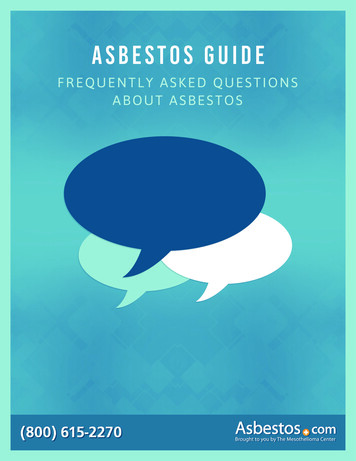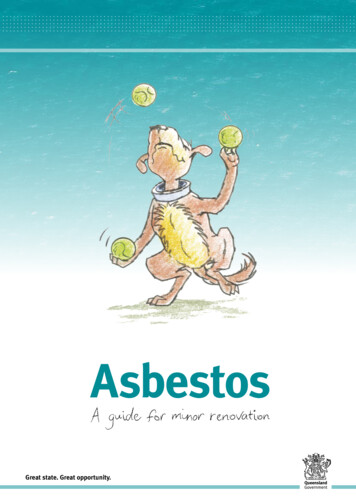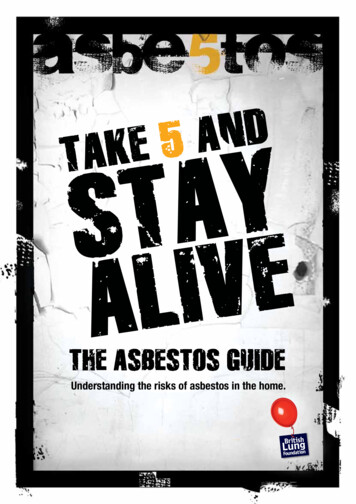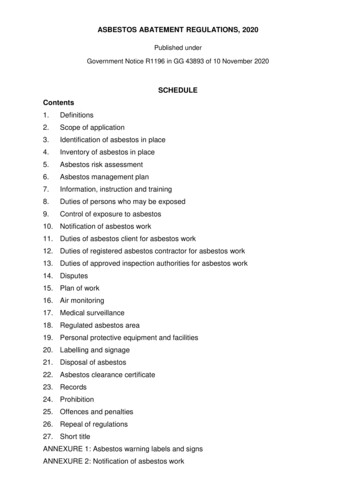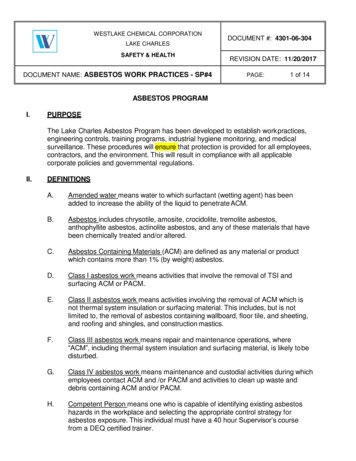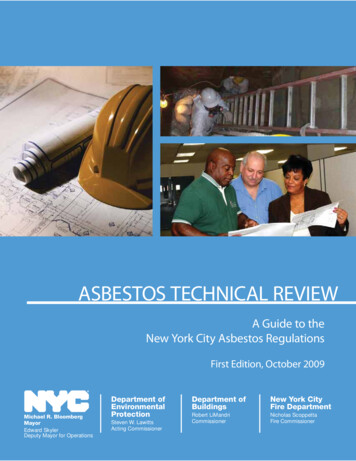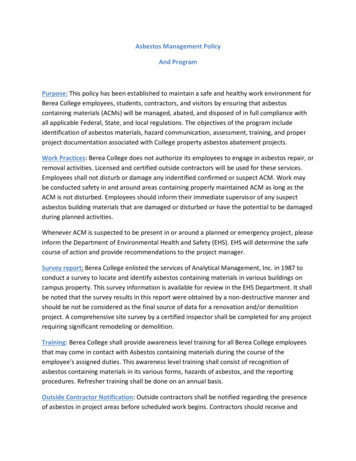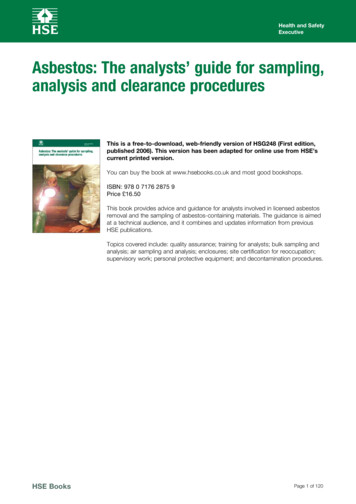
Transcription
Health and SafetyExecutiveAsbestos: The analysts’ guide for sampling,analysis and clearance proceduresThis is a free-to-download, web-friendly version of HSG248 (First edition,published 2006). This version has been adapted for online use from HSE’scurrent printed version.You can buy the book at www.hsebooks.co.uk and most good bookshops.ISBN: 978 0 7176 2875 9Price 16.50This book provides advice and guidance for analysts involved in licensed asbestosremoval and the sampling of asbestos-containing materials. The guidance is aimedat a technical audience, and it combines and updates information from previousHSE publications.Topics covered include: quality assurance; training for analysts; bulk sampling andanalysis; air sampling and analysis; enclosures; site certification for reoccupation;supervisory work; personal protective equipment; and decontamination procedures.HSE BooksPage 1 of 120
Health and SafetyExecutive Crown copyright 2005First published 2005ISBN 978 0 7176 2875 9All rights reserved. No part of this publication may be reproduced, stored ina retrieval system, or transmitted in any form or by any means (electronic,mechanical, photocopying, recording or otherwise) without the prior writtenpermission of the copyright owner.Applications for reproduction should be made in writing to: The Office of PublicSector Information, Information Policy Team, Kew, Richmond, Surrey TW9 4DU ore-mail: licensing@opsi.gov.ukThis guidance is issued by the Health and Safety Executive. Following the guidanceis not compulsory and you are free to take other action. But if you do follow theguidance you will normally be doing enough to comply with the law. Health andsafety inspectors seek to secure compliance with the law and may refer to thisguidance as illustrating good practice.Asbestos: the analysts’ guide for sampling, analysis and clearance proceduresPage 2 of 120
Health and SafetyExecutiveContents1 Introduction 42 Quality assurance and accreditation schemes 73 Training and qualifications 84 Sampling and analysis of materials for the presence of asbestos 105 Sampling and analysis of airborne fibre concentrations 176 Site assessment for reoccupation 267 Supervisory work carried out by analysts 398 Personal protective equipment 419 Decontamination procedures 48Appendices1 Fibres in air: Sampling and evaluation of by phase contrast microscopy 562 Asbestos in bulk materials: Sampling and identification by polarised lightmicroscopy (PLM) 813 Template for certificate of reoccupation 1074 Template for the inspection certificate for the hygiene facility 112References and further information 115Glossary of acronyms 120Asbestos: the analysts’ guide for sampling, analysis and clearance proceduresPage 3 of 120
Health and SafetyExecutive1 IntroductionWhat does this guidance do?1.1This publication consolidates and updates technical guidance from anumber of HSE sources, including previously published guidance notes (EH10,MDHS39, MDHS77), which it now replaces. It mainly deals with analysts involved inlicensed asbestos removal and sampling of asbestos-containing materials (ACMs).Simpler procedures are applicable for small scale and short-term asbestos removalwork (Asbestos essentials)1 and for ACMs which do not require a licence, egasbestos cement (HSG189/2).2 In addition, the publication links in with guidanceproduced for licensed removal contractors entitled Asbestos: The licensedcontractors’ guide.3 This publication contains guidance on: quality assurance;training for analysts;bulk sampling and analysis;air sampling and analysis;enclosures;site certification for reoccupation;supervisory work;personal protective equipment; anddecontamination procedures.1.2Appendix 1 contains details of the future approved analytical method forthe evaluation of fibres in air. Amendments to the European Worker ProtectionDirective4 to be implemented by 2006 will replace the existing European ReferenceMethod (see MDHS39/4)5 with the World Health Organisation (WHO) method.6The updated method has been included to allow analysts to become familiar andtrain with the new method but MDHS39/45 should continue to be used until thenew EU directive is implemented. Appendix 2 gives the analytical method for theidentification of asbestos fibres in materials and contains the same advice as thelast version of MDHS77.71.3Although this guidance covers sampling and analysis of suspectedACMs, it does not go into detail about surveying and assessment of premises forACMs. Surveying is covered in depth in MDHS1008 and further guidance on theassessment and management of asbestos in buildings is given in HSG227.9Who is this guidance for?1.4This guidance is designed for a technical audience, eg asbestos analysts,asbestos consultants, occupational hygienists, safety officers etc. It will also beuseful to asbestos removal contractors and supervisors, employers, buildingowners and people with responsibility for managing properties and estates.Legislation1.5The Control of Asbestos at Work Regulations 2002 (CAWR)10 applies toall work activities involving asbestos-containing materials. It places duties on anemployer, including the self-employed, who carries out, ‘any work which exposesor is liable to expose any of his employees to asbestos ’ to protect all employeesand anyone else who may be affected by the work. There is also a specific dutyAsbestos: the analysts’ guide for sampling, analysis and clearance proceduresPage 4 of 120
Health and SafetyExecutiveunder CAWR10 to manage asbestos in buildings to ensure that asbestos is kept ingood condition and to prevent uncontrolled work or releases.1.6CAWR10 2002 is supported by three Approved Codes of Practice that givepractical guidance on how to comply with the law. Although failure to observe anyof the provisions of an ACOP is not in itself an offence, that failure may be takenby a court in criminal proceedings as proof that a person has contravened theRegulations to which the provision relates. The onus would then be on that personto show that they have complied with the Regulations in an equally effective way.The three ACOPs are described in paragraphs 1.7-1.9.1.7Work with asbestos which does not normally require a licence,11 appliesto work on, or which disturbs, building materials containing asbestos; asbestossampling; laboratory analysis and to the limited, permitted remaining work withasbestos during manufacturing.1.8Work with asbestos insulation, asbestos coating and asbestos insulatingboard12 applies to work defined in the Asbestos (Licensing) Regulations 1983(ASLIC),13 for which a licence is required from the Health and Safety Executive(HSE). It also applies to employers carrying out similar work with asbestosinsulation, asbestos coating and asbestos insulating board using their ownemployees on their own premises, who are exempted from the requirement to holda licence under regulation 3(2) of ASLIC.131.9The management of asbestos in non-domestic premises14 provides adviceon the duties under regulation 4 of CAWR10 to manage the risk from asbestos innon-domestic premises. It explains the duties of building owners, tenants, andany other parties who have any legal responsibility for the premises. It also setsout what is required of people who have a duty to co-operate with the main dutyholder to enable them to comply with the regulation.1.10Employers must consult safety representatives appointed by recognisedtrade unions under the Safety Representatives and Safety CommitteesRegulations 197715 with regard to health and safety issues. Employees notcovered by such representatives must be consulted, either directly or indirectly,via elected representatives of employee safety, according to the Health and Safety(Consultation with Employees) Regulations 1996.161.11Reference to legislation is made at appropriate points throughout thisguidance.Health effects1.12Asbestos-related diseases are currently responsible for more than 4000deaths a year in the UK and the number is still increasing. Asbestos kills morepeople than any other single work-related illness. The diseases can take from15-60 years to develop - so the person who has breathed in the fibres will notbe immediately aware of any change in their health. There is an increased riskof ill health associated with exposure to amphibole asbestos fibres (eg amosite,crocidolite) in comparison with chrysotile (Hodgson and Darnton, 2000).171.13Asbestos can cause two main types of disease in humans: cancer,particularly mesothelioma and lung cancer; and asbestosis (scarring of lung tissue).Other lung changes such as pleural plaques and diffuse pleural thickening, whichare much less disabling, may be indicative of asbestos exposures, but can be dueto other causes. New cases of asbestosis are now rare in the UK.Asbestos: the analysts’ guide for sampling, analysis and clearance proceduresPage 5 of 120
Health and SafetyExecutiveWhat is mesothelioma?1.14Mesothelioma is a cancer of the cells that make up the lining around theoutside of the lungs and inside the ribs (pleura), or around the abdominal organs(peritoneum). By the time it is diagnosed, it is almost always fatal. Like otherasbestos-related diseases, mesothelioma has a long latency period from firstexposure to the onset of disease, on average 30-40 years.What is lung cancer?1.15Lung cancer is a malignant tumour of the lungs’ air passages. The tumourgrows through surrounding tissue, invading and often obstructing air passages.The time between exposure to asbestos and the occurrence of lung cancer is onaverage 20-30 years. It should be noted that there is a synergistic effect betweensmoking and asbestos exposure which significantly increases the risk of developinglung cancer.What is the risk to analysts?1.16All entry into enclosures carries a risk of exposure to airborne fibres.Analysts entering enclosures while removal or remediation work is being carriedout will be potentially exposed to asbestos fibre concentrations above the controllimits. Enclosure entry for other reasons such as bulk sampling or clearanceinspections and air sampling will encounter lower airborne levels.18 However, anydirect disturbance of asbestos during these situations (eg brushing) can potentiallygive rise to short-term high exposure. It is important to be aware that as personalexposure is normally underestimated by static monitoring including clearancesampling, such results will not necessarily reflect personal exposure. Thereforeregular personal monitoring should be carried out to assess individual risks andconfirm the adequacy of respiratory protection. It is recommended that personalmonitoring is performed in 10% of jobs involving enclosure entry.Health surveillance1.17Under regulation 21 of CAWR 2002,10 medical surveillance and healthrecords are required for an employee if the exposure of that employee is likely toexceed the action level (see paragraphs 5.24 to 5.27). The employer should assessthe risks of exposure of his employees to determine the requirement for medicalexamination.1.18Analysts should not normally enter live enclosures. However there will beoccasions when entry is necessary or required (eg for supervision or checkingwhen there are no or insufficient viewing panels). The results of personal airbornemonitoring (see paragraph 1.16) should be used to assist in the risk assessment.1.19If an employer decides on the basis of his risk assessment that medicalexaminations are required, further information can be found in the ACOP Workwith asbestos insulation, asbestos coating and asbestos insulating board12 andAsbestos: The licensed contractors’ guide.3The role of the analyst in asbestos work1.20The analyst may be involved in asbestos work in a number of differentways. Most analysts carry out sampling and analysis of bulk and air samples. Somelaboratories holding supervisory licences will employ analysts in a supervisory rolein asbestos removal (see Chapter 7). More generally however, the analyst’s role hasbeen developing and growing in importance over the years. Most recently CAWR200210 increased the involvement of the analyst in site clearance procedures. Theanalyst now has greater responsibility and opportunities for professional judgement.The analyst is responsible for completing site clearance certification for the workarea, and for issuing a certificate of reoccupation. In addition, some clients may requestAsbestos: the analysts’ guide for sampling, analysis and clearance proceduresPage 6 of 120
Health and SafetyExecutivegreater participation in the asbestos removal work, including pre-clearance inspectionsand surveys, and site management and monitoring, eg overseeing the smoke test andcarrying out some reassurance air sampling during the course of the contract.1.21Although not a legal requirement, it is desirable that the analyst isemployed by the building owner or occupier for site clearance certification. Thisarrangement avoids any conflict of interest (perceived or real) that may arise shouldthe analyst be employed by the removal contractor. It also enables an independentparty to be involved in resolving any problems that arise during the clearanceprocess. In addition, it has a practical advantage in that all results and certificatesof reoccupation can also be issued directly to the person who has responsibility forthe premises as well as to the contractor.2 Quality assurance andaccreditation schemes2.1 Regulation 19 of CAWR 200210 requires that employers who uselaboratories to undertake air sampling and analysis of air samples should assurethemselves that the laboratory conforms with the competence standardISO/IEC 17025.19 Regulation 20 of CAWR 2002,10 which came into effect on 21November 2004, also requires that employers who engage laboratories to analyseasbestos materials assure themselves that the laboratory also conforms with ISO17025. Conformation with ISO 17025 is demonstrated by obtaining accreditationfrom a recognised body. The United Kingdom Accreditation Service (UKAS)is currently the sole recognised accreditation body in Great Britain. The UKASdocument which details the accreditation requirements and procedures (UKASpublication LAB 30 Application of ISO/IEC 17025 for asbestos sampling andtesting)20 is published on the internet, and can be downloaded from their website,www.ukas.com.2.2The asbestos site clearance certification process requires activities to beundertaken by accredited laboratories. The air sampling requirement is outlinedin paragraph 2.1. The visual inspection procedures should be undertaken bylaboratories that can demonstrate compliance with ISO 17020.21 UKAS is alsooffering accreditation for this activity but ISO/IEC 1702520 remains the leadstandard. Separate UKAS accreditation for surveying buildings for ACMs underISO 1702021 is also available to laboratories. Individual accreditation under ISO/IEC 1702422 will also be available in the near future. Accredited laboratories, andthe specific methods the accreditation covers, are listed at www.ukas.org. Furtherinformation can be obtained from UKAS.2.3This document specifies additional requirements for laboratories thatundertake air or material sampling. Those laboratories that analyse air samplesmust take part, and achieve a satisfactory standard, in an external qualityassurance scheme for analysis of air samples. This requirement is set out inAppendix 1. The scheme is called the Regular Inter-laboratory Counting Exchange(RICE). It is administered by the Health and Safety Laboratory (HSL) on behalf ofHSE and overseen by the Committee on Fibre Measurement (CFM).2.4The scheme for the identification of asbestos in materials is called theAsbestos in Materials Scheme (AIMS). This scheme is also administered by HSLon behalf of HSE and overseen by CFM. Participation and the maintenance of asatisfactory performance in this scheme is a requirement of Appendix 2 of thisAsbestos: the analysts’ guide for sampling, analysis and clearance proceduresPage 7 of 120
Health and SafetyExecutiveguidance. Further information and contact details on both schemes can be foundon HSL’s website at www.hsl.gov.uk.3 Training and qualifications3.1Regulation 9 of CAWR 200210 requires employers to ensure that adequateinformation, instruction and training are given to their employees who are liable tobe exposed to asbestos. The aim of this regulation is to ensure that employeesare equipped with the relevant skills and knowledge to enable them to worksafely by minimising their exposure to asbestos. Training alone does not makepeople competent. Training must be consolidated by practical experience so thatthe person becomes confident, skilful and knowledgeable in practice on the job.The ACOP, Work with asbestos, which does not normally require a licence,11paragraphs 52-56, sets out in some detail the areas of training that need to becovered when working with asbestos.3.2When drawing up a training programme for asbestos analytical staff,the training manager will first need to review the functions that the analyst willundertake. There will be different training needs for different functions. Functionswill include: laboratory-based analysis of air and bulk samples;sampling surveys for asbestos in buildings;clearance of enclosures and hygiene facilities;supervisory licence work.The training will normally consist of the following areas: organisation-specific training;health and safety training;function-specific training and qualifications;ongoing/refresher training and assessment.Organisation-specific training3.3This may cover a range of topics associated with the establishedworking procedures. It will usually include many items associated with ISO 17025accreditation.Health and safety training3.4The training manager needs to devise or source training programmes thatinclude:the health effects of exposure to asbestos fibres;methods to reduce the risk when working with asbestos;safe handling and use of chemicals;ergonomic issues and requirements;company health and safety policy and procedures;selection, fitting, wearing and care of respiratory protective equipment (seeChapter 8); use of personal protective equipment; Asbestos: the analysts’ guide for sampling, analysis and clearance proceduresPage 8 of 120
Health and SafetyExecutive the meaning and interpretation of action and control levels and clearanceindicator levels; emergency procedures.Field staff training will also need to address topics such as: working in confined spaces;working at heights;lone working;working in hot environments;decontamination procedures.Field staff who have to enter enclosures will have to complete practical trainingon RPE and decontamination as detailed in modules 24 and 25 of Asbestos: Thelicensed contractors guide3 (see also Chapter 9).Function-specific training and qualifications3.5Part of the accreditation process requires analytical laboratories todemonstrate that their employees are competent. Accreditation requires atleast one senior member of an accredited laboratory’s team to hold the BritishOccupational Hygiene Society (BOHS) Certificate of Competence in Asbestos.This BOHS Certificate is gained by two examinations, one written (S301 ‘Asbestosand other fibres’) and one oral. BOHS can provide information regarding relevantcourses and the written examination. It is not a requirement that a candidate sittingthe S301 examination attends a training course. Once candidates have passed thewritten examination and have gained six months practical experience they can thenapply to BOHS to sit the oral examination. A prerequisite of the oral examinationis the submission of a written report on a suitable asbestos subject, often anasbestos survey, which must be acceptable to the examiners.3.6BOHS has also developed a series of five proficiency modules for trainingindividuals in specific areas of asbestos work. These are: P401:P402:P403:P404:P405:identification of asbestos in bulk samples;buildings surveys and bulk sampling for asbestos;asbestos fibre counting;air sampling and clearance testing of asbestos;management of asbestos in buildings.The accreditation process will require that all analysts carrying out asbestos work inthe above areas must have, as a minimum, the appropriate P module or the S301exam. This is being phased in and the P401 should currently be held by all analystscarrying out asbestos material analysis.3.7Each proficiency module is a stand-alone training course of 2-3 daysduration, which is in a specific and individual area of asbestos work and coversboth theory and practical training in the subject area. The aim of each proficiencymodule is to help individuals to become proficient to carry out the work coveredby the module. All of the modules have practical assessments as well as a writtenexamination. Any candidate who has been awarded a certificate of proficiencyfor all five modules will be deemed to have passed the written part of the S301examination (‘Asbestos and other fibres’). There would still be a requirement topass the BOHS oral examination to be granted a certificate of competence. Detailson training courses and course providers can be obtained from BOHS (see ‘Furtherinformation’ section).Asbestos: the analysts’ guide for sampling, analysis and clearance proceduresPage 9 of 120
Health and SafetyExecutive3.8Practical, on-the-job training is essential and should be carried out underthe supervision of an experienced analyst to enable assessment of the trainee’scompetence. Accreditation requires that a laboratory has a documented trainingprocedure which should include an element of supervised on-site experience.Internal and external quality control (QC) schemes are ideal for assessingcompetence (ie for the analysis of samples of airborne asbestos fibres and bulkanalysis). Other procedures have to be developed in-house for air and bulksampling – including site auditing before authorisation to carry out the task(s)unsupervised. Assessment of an analyst’s competence must be confirmed by anappropriate senior laboratory member before any unsupervised site work.3.9Training for those fulfilling the function of a supervisory licence-holder (SLH)should cover all the subjects, at an appropriate level, in training modules 1-19and 24-27 listed in Chapter 4 and Appendices 1 and 2 of Asbestos: The licensedcontractors’ guide.3 Where relevant BOHS qualifications are held, a training needsanalysis should be used to identify the outstanding modules that are required. Itis anticipated that future BOHS courses will be modified to reflect these trainingmodules and thereby reduce the training load.Ongoing/refresher training3.10If an analyst is required to carry out more functions, additional training forthose functions will be necessary. The ACOP L2711 states that refresher trainingshould be carried out on an annual basis for those whose work regularly disturbsasbestos. This refresher training should be relevant to the needs of the employeeand to the work they undertake. For analysts this should include an update onany changes to guidance, ACOPs and regulations, a sharing and update of goodpractice and identification of bad practice, particularly in those areas of work thatare difficult to measure, eg visual inspections, surveys.3.11The ongoing quality of the work carried out by analysts should be keptunder review. For visual inspections related to providing certificates of reoccupation,other schemes need to be developed. A programme of accompanied/observedinspections on a regular basis would contribute to a successful internal qualityassurance scheme. A briefing session or retraining might be the outcome of suchan inspection. The importance of periodic and comprehensive internal auditing ofanalysts’ performance cannot be over-emphasised.4 Sampling and analysis ofmaterials for the presence ofasbestos4.1 Sampling and analysis of materials for the presence of asbestos is normallyundertaken to comply with CAWR 2002.10 This may be as part of the duty tomanage asbestos under regulation 4, or to comply with regulation 5. Regulation 5requires employers of the people who are going to work with asbestos to identifythe asbestos type(s) by analysis or to assume the material contains the mosthazardous type(s) of asbestos (ie crocidolite and/or amosite). The purpose of thesampling is to collect representative samples of the suspect materials. The purposeof the analysis is to determine whether asbestos is present, and, if so, the type(s).Asbestos: the analysts’ guide for sampling, analysis and clearance proceduresPage 10 of 120
Health and SafetyExecutive4.2This chapter summarises the requirements for the sampling and analysisof suspected ACMs. Detailed information relating to the methods to be used inthe analysis of materials for asbestos can be found in Appendix 2. MDHS100,Surveying, sampling and assessment of asbestos-containing materials8 also coverssampling strategies and the reporting requirements for surveys in some depth.4.3Sampling ACMs can give rise to exposure to asbestos and is thereforealso covered by CAWR 2002.10 The Regulations require an assessment and plan ofwork to be made, and for the latter to set out the control measures and personalprotective equipment (PPE) to be used. A generic risk assessment for sampling ofACMs should be supplemented by a site-specific risk assessment with appropriatecontrol measures (see paragraph 4.4). It also requires that adequate information,training and refresher training have been given to the sampling personnel. SamplingACMs is however, exempt from the Asbestos (Licensing) Regulations 198323 asamended.Bulk sampling strategySafe systems of work4.4All sampling-related work must have an adequate risk assessment. Theaim is to ensure that analysts and others including building occupants are not putat risk by the sampling. As well as the risks posed by the disturbance of asbestos,other hazards must be taken into account, in particular the risks from working atheights. It is recommended that surveys are conducted with two people workingtogether. Two people are essential when work at height is involved and mandatorywhen dust control is employed, eg shadow vacuuming. Where working at heightsis necessary, access platforms should be used where reasonably practicableto minimise the risk of a fall. Sampling personnel must wear adequate personalprotective equipment, as determined by the risk assessment under CAWR.10 Thetype of material sampled and the amount of disturbance of asbestos material willdictate the type of respirator. Airborne emissions should normally be controlled bypre-wetting the material to be sampled with water and/or a suitable wetting agent.Shadow vacuuming with a Type H vacuum cleaner should be used if wetting islikely to be incomplete or inappropriate (eg near live electrical equipment).4.5The areas to be sampled inside buildings should as far as possible beunoccupied and entry restricted during the sampling. The work should minimise thedisruption to the clients’ operations. The nature of the area and the likely release ofdust will dictate the precautions required to prevent the spread of asbestos.Strategy4.6Whether samples of suspect ACMs are being taken on an individual basisor as part of a survey, it is important that a sample(s) truly represents the locationand the material from which it is taken. After assessing the extent of the materialand any variations or repairs, representative samples of about 3-5 cm2 area andthrough the entire depth of the suspect material should be taken. The samplesmust be representative of the whole material. Particular attention should be paidto ensure that the full inner edge or remote side are captured. Samples shouldnormally be collected from the less conspicuous areas, or from where it causesleast additional damage, eg the edges of tiles, boards and sheets or areas whichhave already been damaged.4.7The sampling strategy will be based on the types of ACM present. Thefollowing list is a guide to sample numbers and locations. However, a decisionon the appropriate number of samples per location should be made after closeinspection of the materials involved. More information is given on this in paragraphs4.8-4.9.Asbestos: the analysts’ guide for sampling, analysis and clearance proceduresPage 11 of 120
Health and SafetyExecutive Spray coatings, encapsulated sprays and bulk materials. These are usually, but not always, homogeneous and normally two samples should be enough iftaken at either end of the sprayed surface. More samples will be necessary ifthe installation is particularly large or there are areas of repairs or alterations.Pipe/thermal insulation. Pipe insulation is often highly variable in composition,especially where there is a change in colour, size and texture or where thereis evidence of repairs or modifications. The number and location of sampleswill be dictated by the amount of variation and the planned or subsequentactivities. Samples should initially be collected from areas that have no visiblesign of having been patched or repaired. Areas to avoid include valves andhatches, or those close to access routes that are likely to be subject to repairand so less likely to contain asbestos.Insulating board/tiles. Insulating board is usually homogeneous but repairsmay have been performed and/or replacement boards and tiles may havebeen fitted. One 3-5 cm2 sample per room or every 25 m2 is usually adequate.If there is evidently more than one type of panel then representative samplesof each should be taken. When a material is visually consistent with asbestosinsulating board, smaller samples may suffice as the amosite is readilydetectable on analysis.Asbestos cement materials. These are homogeneous materials that arecommonly encountered as corrugated and flat sheets or as various mouldedproducts. In older buildings, most pre-forme
1.7 11Work with asbestos which does not normally require a licence, applies to work on, or which disturbs, building materials containing asbestos; asbestos sampling; laboratory analysis and to the limited, permitted remaining work with asbestos during manufacturing. 1.8 Work with asbestos insulation, asbestos coating and asbestos insulating


